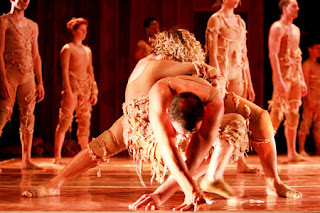On Tuesday I learnt the four “CONDITIONS
FOR THEATRE”, which are:
1. Involvement of the body to represent another person in a certain
time and place trough performance.
2. Order, composition and game.
3. A content, something to say
4. A social and ritual function
And on Thursday we had the
opportunity to watch “La consagración de la primavera”, presented by the
“Ballet de Londrina” from Brasil.
There, I had the opportunity to
think about the four conditions for theatre and comparing the dancing spectacle
with what would be a theatrical play.
Should this presentation be
considered a play?
There was an involvement of the
dancers’ bodies to represent other characters, a content or something to say
about a virgin’s sacrifice, and maybe the social function of showing this idea
and the concept of its unfairness.
However, there was not an exact or
clear composition of the story/plot and characterization, as it was not focused
in telling a story, but in delighting the audience with the dancers’ abilities
and skills.
This idea can be connected to
Opera, as the Opera spectators do not assist to see the plot, but to hear the
music. For a very similar reason (as we were discussing in class), ballet
performances usually represent “the same” or traditional stories (such as the
Swan lake or The Nutcracker), as the stories entertain the audience and make
the presentations more ‘dynamic’, but are not the “focus point”.
So… This was a DIFFERENT EXPERIENCE
to the experiences that all the plays have given us. We were expected and able
to appreciate the dance moves and tremendous bodywork.
*In Western Theatre, we usually go
to concentrate on a plot or story, which should entertain us.
For example, in plays such as
"Más pequeños que el Guggenheim", "Los músicos ambulantes",
and even "Shadow Queendom", the audience is interested in the STORY
that is being told, and wants to know how it will develop and end.
However, comparing this new
experience to the Kabuki tradition, the audience goes to appreciate the ACTOR
(in this case the dancer's skills), and not the plot.
In just 13 days we will be
travelling to Paucartambo, and I ask myself.. how are the 4 conditions of
Theatre applied there?
Should the audience be more
concentrated in the dancing, music and atmosphere created rather than in a
specific story or plot?
What is the most important aspect
in the celebration of "Mamacha Carmen"? The acting? the irony in the masks, costumes and
representations about past characters and events? the 'story' of
Qollarri's daughter being captured by Inkarri??
What kind of experience do
the "Paucartambinos" want to give to their audience?
In musicals (such as Hairspray),
should the audience be concentrated mainly in the story or in the
singing?
Are the performers in Paucartambo actors or dancers? and if they are dancers, why should it be considered theatre?
Are the performers in Paucartambo actors or dancers? and if they are dancers, why should it be considered theatre?

Other reflections/comments about "La consagración de la Primavera":
ResponderEliminar**If you want to present a long spectacle it should not be REPETITIVE, and needs to be innovative to entertain the audience
(the presentation was kind of short, but as it was becoming repetitive, in my opinion the time was not 'bad').
**If a "group" is being represented, it may work better if the individuals have similar hair styles, and aspects such as big tattoos and "extravagant hairs" are avoided.
**Usually, when actions are done in big groups, they capture more the audience's attention/ seem more interesting.
Even though there is still a lot of transcription of what we did in class, the questions you reach in this entry are focused enough to stimulate further learning.
ResponderEliminarRoberto